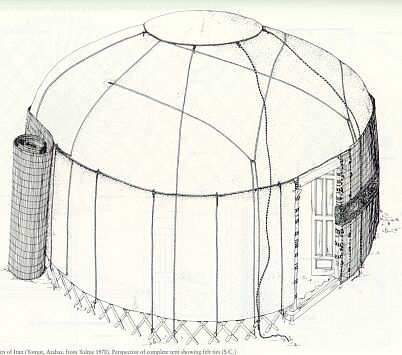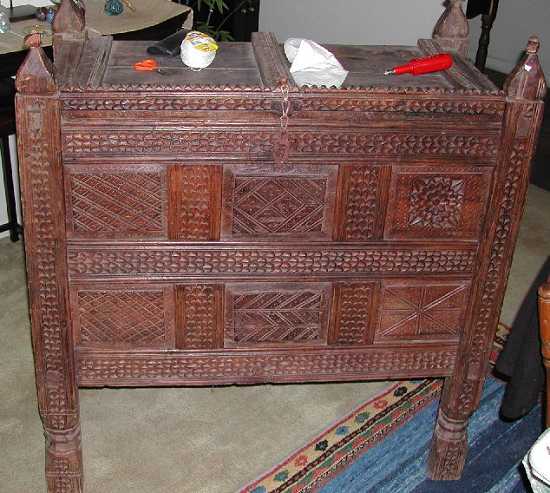Posted by Steve Price on 09-19-2002 10:13 AM:
The Hatchli Layout
Hi People,
If my memory is correct (and I know, it usually
isn't), the subject of how the hatchli layout for ensis came to be hasn't come
up.
I propose a rather unromantic notion. It's done that way because
(wooden) doors are done that way, even when they are used on yurts.

Doors are done that way for a fairly uninteresting (or,
at least, unromantic) reason: it's hard to get a single piece of wood big
enough to make into a door, and even if you did use a big single piece of wood,
it would crack and warp. So, we make doors by piecing together several small
pieces, oriented in different directions relative to the grain of the wood.
And, the ensi being a woven door, one of its usual layouts is that of a wooden
door.
Regards,
Steve Price
Posted by Chuck Wagner on
09-19-2002 11:16 AM:
This shoe fits...
Hi Steve,
The door analog is my personal favorite, for the
following reasons:
1) Rigid, intrusive geometry
It's very unusual
in the carpet world to have such a bold cross-cutting orthogonal design element
splattered all over the field of a rug. Around the sides (borders), yes.
Corners (spandrels), yes. Parallel lines (Afshars & Baluchis), yes. But
huge crossbars ? No.
2) Proportions and layout
The similarity to
wooden yurt door designs (at the major design element level) is strong. The
width and positions of the ensi "crossbeam" design elements are consistent with
structural elements of wood doors.
The minor "door panel" areas between
the "crossbeam" and "frame" areas are generally filled with detail work that is
similar in scale to that found on chip-carved wooden goods such as the chests
found in yurts, and door carvings from central and south Asia.

It's certainly plausible to propose that the shamanist
or tokenist design elements were transferred from other woven goods (or other
art forms) onto the ensi format. And because I like the notion of ensis as
dividing walls within yurts (or oys), I also wonder if there's a gender
component to the "door panel" design details (mens area vs. womens
area).
3) Lack of cross cultural design transfer
A lot of
designs in the carpet world tend to grow legs and wander across cultural and
ethnic borders. The ensi doesn't seem to have done so.
4)
Practicality
Find a picture of a forest in the Turkoman inhabited
regions. Then sell it for lots of money because very few people have
one.
In addition to scarcity, wood doors are heavy and cumbersome and
not nearly so convenient as something that rolls up and lashes easliy to the
side of a camel.
Regards,
Chuck
__________________
Chuck Wagner
Posted by Steve Price on 09-19-2002 12:59 PM:
Hi Chuck,
I ought to close this thread to further posts now that
one person thinks I'm right about one thing!
Oh, did anyone notice the
elems at the bottoms of just about every wooden door?

Regards,
Steve
Price
Posted by Marvin Amstey on 09-19-2002 01:22 PM:
That's not an elem, that's a kick plate.
Posted by Steve
Price on 09-19-2002 01:37 PM:
Hi Marvin,
Strictly speaking, a kick plate is a piece of
something (often brass) that covers the lower horizontal panel of wooden doors.
The lower panel is just a structural member that happens to be at the bottom.
IF the hatchli layout is derived from that of wooden doors, then the elem is in
the spot that the lower panel occupies.
And, before anyone points out
that there are such things as flush doors - doors with simple, flat, one piece
surfaces: the surfaces of flush doors are veneers. If you look inside, you'll
find a layout of wooden parts not too different than what you see in paneled
doors. The construction is dictated by the availability of large pieces of wood
and especially by the tendency of large pieces of wood to develop cracks and to
warp.
I don't know that the hatchli layout is derived from wooden
doors, but it's something to consider. If that should turn out to be the case,
one interesting consequence would be that the layout of most ensis is derived
from the structural demands that dictate the layout of wooden doors. Those
structural demands, obviously, are not structural demands for ensis. In some
ways this reminds me of Marla Mallett's arguments about the origins of
latchhooks as things dictated by the structural demands of slit kilims that got
transferred into pile weavings.
Regards,
Steve Price
Posted by Filiberto Boncompagni on 09-19-2002 02:22 PM:
Hi Steve,
I already suggested the correspondence between a real
door and the cruciform format in "Candles in the garden" part one.
After
that I realized that John had said the same thing in the second part of this
Salon: At a most obvious level, the existing literature has suggested that
the "hatchli" format with its "cross-like" shape can be seen to mimic the
panels in many wooden doors.
That’s the problem with long
Salons. One tends to forget previous
postings.
Regards,
Filiberto
Posted by Steve Price on
09-19-2002 02:36 PM:
Hi Filiberto,
That's the problem with being old and forgetful.
This reminds me a little of a story I heard in the early 1960's. I was
working for Monsanto Company near Boston, also home to Polaroid Corporation.
Polaroid's founder (Edwin Land), getting along in years and about as forgetful
as I am now, used to come into the company's labs periodically all excited
about his latest brilliant idea. The lab folks would have the sad
responsibility of telling him that he had already invented
that.
Regards,
Steve Price
Posted by R. John Howe on
09-19-2002 04:13 PM:
Dear folks -
In the Walter Denny catalog for the Turkish
classical rug exhibition I have been whooping about, Walter too faces the
problem of alternative explanations and gives a famous quote from William
Occam:
"What can be done with fewer assumptions is done in vain with
more."
Might it be that the "mimicing many wooden doors" thesis as an
explanation of the "hatchli" layout, is likely correct because it requires the
fewest assumptions?
Not near as much fun, though, despite the surprising
"eddies" in this thread even to this point.
Regards,
R. John
Howe


